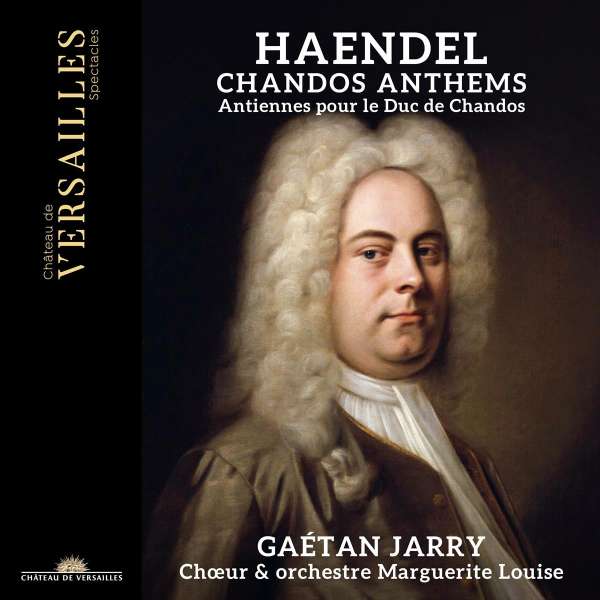Aus der Sammlung von elf Kantaten, die der Komponist Georg Friedrich Händel auf dem Schloss Cannons schrieb, bekannt als Chandos Anthems, haben die Interpreten drei Stück eingespielt. Zur abwechslungsreichen Gestaltung sind eine Chaconne und das Voluntary für Orgel darin eingefügt.
Die Texte stammen aus dem Buch der Psalmen. Auffällig ist das Fehlen der Altstimmen in den ersten sechs Anthems sowie das Fehlen der Bratschen, wohl weil sie in Cannons nicht zur Verfügung standen. Nach einer instrumentalen Einleitung schließen sich jeweils Sätze für Chor und Solisten an. Die Orchestrierung ist sparsam und damit kammermusikalisch geprägt, zeigt aber in ihrer Kraft und Würde den selbstbewussten Geist ihrer Epoche. In diesem Psalmenkorpus gelingt Händel die geniale Assimilation aller europäischen Stile.
Die Sopranistin Florie Valiquette kann im Anthem IV (O sing unto the Lord a new song!) ihren runden Klang und feine Phrasierungen zur Geltung bringen. Aber erst in Tears are my daily food aus Anthem VI überzeugt sie nicht nur, sondern fesselt gar durch die Interpretation, die sie flehentlich und mit guter Atemkontrolle anlegt.
Bei seinen Soli stellt Tenor Nicholas Scott seine brillante, homogene und kraftvolle Stimme mit Leichtigkeit zur Schau. Mit anfangs etwas kurzem Atem zeigt er schnell, dass er eine erste Wahl ist, da er vor allem mit der Expressivität seines Gesangs aufwartet. Seine Spracharbeit ist aufmerksam und stets klar in der Aussprache.
Valiquette und Scott teilen sich Duettauftritte. In Anthem IV (Worship the Lord) etwa liegt der Reiz im Kontrast ihrer Klangfarben. Sie hat eine rundere Stimme mit weichen Vokalisen, während er eine offenere Stimme pflegt, deren Verzierungen abrupter sind. Das Duett in Nummer VI (Why so full of grief) ist ausgeglichener mit rührender Doppelpräsenz.
Virgile Ancelys Stimme fehlt es etwas an Timbre. Seine Phrasierungen weisen zwar schöne Zartheit auf, aber es fehlt ihnen die Sicherheit in der Führung, um vollends zu überzeugen.
Das eigentlich packende an den Chandos Anthems ist der hervorgehobene Platz, den der Chor einnimmt. Die Choristen des Ensembles Marguerite Louise singen mit großer Homogenität, die dennoch die Klarheit wahrt, um die fugierten Teile zu genießen. Unter der Leitung von Gaétan Jarry entfalten Chor und Orchester eine reiche, gut eingesetzte Farbpalette, die der Expressivität dient. Wenn diese Farben manchmal abrupt werden, dann überraschen sie mit ihrer Brillanz. Beispielhaft sei das Glory des Antiphons I genannt, das mit der Kraft und Sanftheit des Amen kontrastiert, das dieses Antiphon majestätisch beendet. Ebenso bemerkenswert sind die Leistungen des Oboisten und der Solovioline, deren Virtuosität einfühlsam und engagiert ist.
Der Dirigent Gaétan Jarry ist auch der Organist, der die beiden Einschübe mit Agilität und theatralisch wirkendem Ansatz hantiert, indem er mit den verschiedenen Registern der Orgel jongliert und so mit den verschiedenen Klangfarben des Instruments spielt.
From the collection of eleven cantatas written by the composer George Frideric Handel at Cannons Castle, known as Chandos Anthems, the performers have recorded three pieces. For variety, a Chaconne and the Voluntary for organ are included.
The texts are from the Book of Psalms. Conspicuous is the absence of the alto parts in the first six anthems as well as the absence of the violas, probably because they were not available in Cannons. An instrumental introduction is followed by movements for chorus and soloists. The orchestration is spare and thus chamber-musical in character, but in its power and dignity it shows the self-confident spirit of its era. In this corpus of psalms, Handel succeeds in ingeniously assimilating all European styles.
Soprano Florie Valiquette is able to show off her rounded sound and fine phrasing in Anthem IV (O sing unto the Lord a new song!). But it is in Tears are my daily food from Anthem VI that she not only convinces, but even captivates with her interpretation, which she applies pleadingly and with good breath control.
In his solos, tenor Nicholas Scott displays his brilliant, homogeneous and powerful voice with ease. With a somewhat short breath at first, he quickly demonstrates that he is a first choice, as he shows off the expressiveness of his singing above all else. His voice work is attentive and always clear in pronunciation.
Valiquette and Scott share duet performances. In Anthem IV (Worship the Lord), for instance, the appeal is in the contrast of their timbres. She has a rounder voice with soft vocalizations, while he cultivates a more open voice whose ornaments are more abrupt. The duet in number VI (Why so full of grief) is more balanced with a touching dual presence.
Virgile Ancely’s voice is somewhat lacking in timbre. His phrasings exhibit nice delicacy but lack the lead assurance to be fully convincing.
What is actually gripping about the Chandos Anthems is the highlighted place the chorus occupies. The choristers of the Ensemble Marguerite Louise sing with great homogeneity, yet maintaining the clarity to enjoy the fugal sections. Under the direction of Gaétan Jarry, the chorus and orchestra unfold a rich, well-used palette of colors that serve expressivity. When these colors sometimes become abrupt, they surprise with their brilliance. An example is the ‘Glory’ of Antiphon I, which contrasts with the power and gentleness of the ‘Amen’ that majestically ends this antiphon. Equally noteworthy are the performances of the oboist and the solo violin, whose virtuosity is sensitive and committed.
The conductor, Gaétan Jarry, is also the organist, handling the two interludes with agility and a theatrical approach, juggling the various stops of the organ to play with the different timbres of the instrument.


















